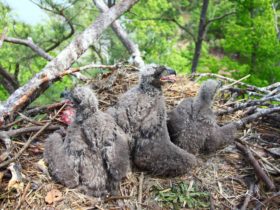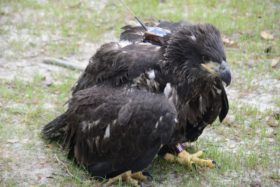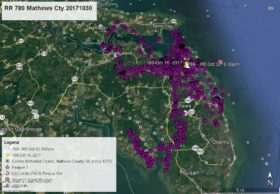Hi – My Name is Camellia
Azalea in Perquimans County, NC
May 3, 2010All Three Eaglets Are Now Banded
May 5, 2010
Today, May 5, 2010, the oldest of the three eaglets at Norfolk Botanical Garden was fitted with a satellite transmitter by Libby Mojica, Raptor Biologist at The Center for Conservation Biology, and given the name Camellia for tracking purposes. The measurements and weight fell in between the norms to identify male or female gender, but whether its a boy or girl – right or wrong – this eaglet will be known as Camellia.
Camellia has its own web page and you are encouraged to become an adoptive parent at http://www.wildlifetracking.org/index.shtml?tag_id=74435.
More than 1,000 people participated in the “eaglet naming” and Camellia got the most votes. Other top names were Magnolia, Cedar, Iris, Acer and Rose. Thanks to all who participated.




6 Comments
Camellia “right or wrong” , I was honored to adopt “it”. :-))
Thanks Reese
I think Camellia is definitely a female . She is a beauty. Reese how in the world are you going to keep up with 2 girls ? lol AZ is a full time job. I should expect her to come this way too – after all her band is NC.
I just wish for these 3 a long healthy life free from harm. Thank you ALL for such a wonderful journey thru the lives of Eagles. Great job Libby.
Dixie
Welcome Camellia. I have known her (I’ll bet it’s a she) since she first pipped – and now I have officially adopted her – happy day. Gives me a sense of hope in the midst of so much distressing news elsewhere.
Thanks to everyone for all the ways you have enriched my life. I loved watching and listening to the live banding this AM, and will be keeping a close eye on Cemellia-girl!
Camellia – I have loved you since you were in your egg! I can’t wait to follow your adventures, just as I have followed the travels of your adorable big sister, Azalea. You two stay safe!!
Is there any memory capacity for storage of tracking data within the transmiiter device in the event the
antenna signal is permanently lost for some reason and then unit is subsequently found and returned to you?
Eagle Eye – good question. The transmitter will save up to 6 days worth of data before it is written over by new data. I’m happy to keep answering questions on the transmitters if you’ve got any more. I’ve been using these units for over 10 years and the hardware and circuit boards have come a long way since then. The units are smaller, lighter in weight, and collect more accurate data. We’ve benefited from the cell phone industry pushing for smaller circuit boards and on-board GPS chips. Additional information on transmitter specs is on the EagleTrak page.
http://www.ccb-wm.org/eagletrak/